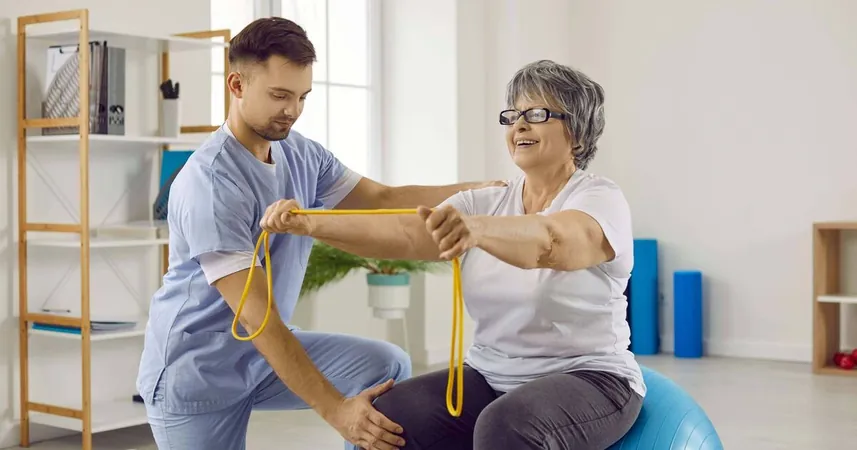
The 'Invisible Epidemic': One in Three Women Suffer from Osteoporosis - But Here's the Vitamin That Can Help!
2025-01-11
Author: Siti
The Dangers of Osteoporosis
From the onset, osteoporosis can remain unnoticed until a fracture occurs. Sam Bhide, a knowledgeable physiotherapist, explains, "It is frequently referred to as the 'silent disease' because it progresses without symptoms until a fracture occurs." Kirsty Carne, a senior osteoporosis specialist nurse, highlights that while the bones may be deteriorating, patients often experience little to no discomfort, with pain only surfacing post-fracture.
Everyday Risks
Everyday activities can turn dangerous for those with osteoporosis. Carne elaborates, "Osteoporosis is a condition where the bones become weaker and break more easily, even after a minor bump or fall." Frailty makes it possible to suffer fractures from tasks as mundane as lifting a pot or bending down to retrieve a dish from the oven.
Risk Factors to Consider
Age, genetics, and lifestyle choices greatly influence osteoporosis risk. Bone density decreases naturally over time, and family history can play a significant role as well. Poor nutrition, particularly inadequate intake of calcium and vitamin D, along with lifestyle choices like smoking and excessive alcohol consumption, exacerbate the risk.
The Importance of Early Detection
Early diagnosis of osteoporosis is pivotal. According to Bhide, "Identifying the condition early can prevent fractures and complications, allowing timely interventions to slow down bone loss." This proactive approach to health not only promotes well-being but also reduces healthcare expenses.
Diagnosis usually occurs through a bone density scan (DXA scan) for individuals exhibiting risk factors or who have suffered a fragility fracture. This scan assesses fracture risk and determines the potential benefit of treatments. In some older adults with a history of significant fractures, treatment might start without needing a scan, based solely on their medical history.
Lifestyle Adjustments for Healthier Bones
Maintaining a healthy lifestyle is paramount in preserving bone health. Carne recommends ensuring a diet rich in nutrients, including at least 700mg of calcium daily and 400 international units of vitamin D, particularly in winter months. Avoiding smoking and limiting alcohol intake can significantly aid in decreasing osteoporosis risk.
Additionally, incorporating regular weight-bearing and resistance exercises can reinforce bones. "Aim for at least 150 minutes of weight-bearing exercise weekly," advises Carne. Combining aerobic activities like jogging with muscle-strengthening exercises is vital.
Treatment Advances
While there is currently no cure for osteoporosis, numerous effective treatments exist. "We have medications that can strengthen your bones and reduce fracture risk," Carne explains. Typically, individuals may engage in a cycle of medication, taking it for a few years, possibly pausing, and then resuming as necessary based on their bone health.
These treatments may manifest as tablets, injections, or intravenous infusions, with alendronate being a common choice for many patients.
Conclusion
In conclusion, osteoporosis is an alarming condition that silently afflicts many, especially women. By staying vigilant and adhering to dietary recommendations, regular exercise, and treatment options if required, individuals can combat the risks of this 'invisible epidemic.' Stay informed—your bones will thank you!




 Brasil (PT)
Brasil (PT)
 Canada (EN)
Canada (EN)
 Chile (ES)
Chile (ES)
 Česko (CS)
Česko (CS)
 대한민국 (KO)
대한민국 (KO)
 España (ES)
España (ES)
 France (FR)
France (FR)
 Hong Kong (EN)
Hong Kong (EN)
 Italia (IT)
Italia (IT)
 日本 (JA)
日本 (JA)
 Magyarország (HU)
Magyarország (HU)
 Norge (NO)
Norge (NO)
 Polska (PL)
Polska (PL)
 Schweiz (DE)
Schweiz (DE)
 Singapore (EN)
Singapore (EN)
 Sverige (SV)
Sverige (SV)
 Suomi (FI)
Suomi (FI)
 Türkiye (TR)
Türkiye (TR)
 الإمارات العربية المتحدة (AR)
الإمارات العربية المتحدة (AR)